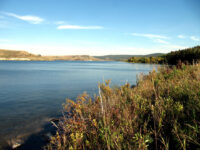Coal, calcite and cutthroats
By SUBMITTED BY THE SOUTHERN ALBERTA GROUP FOR THE ENVIRONMENT on November 26, 2020.
Calcite build-up on streambeds is an environmental hazard of open-pit mountaintop coal mining proposed in the headwaters of the Oldman River. As with selenium pollution, described in a previous article, water flowing through waste rock accumulated during the coal mining process dissolves calcium carbonate and carries it downstream.
Unlike selenium, calcium carbonate is not considered a toxic pollutant in water. However, when calcium carbonate reaches a high enough concentration, it solidifies into calcite. The process is similar to the buildup that forms in tea kettles and humidifiers. Calcite coats the stream bottom and, in effect, turns it into concrete. In some cases streambed sands and gravels can only be broken free with hammer blows.
Where calcite accumulates, the stream bottom becomes uninhabitable to invertebrates that form the base of the aquatic food chain. Aquatic plants are smothered. Trout that use an undulating movement to flush sediment and excavate hollows in loose gravels for laying eggs, referred to as redds, can no longer spawn. This is especially devasting to native cutthroat and bull trout, both “threatened” species, federally and provincially.
In reaches where a stream bottom becomes cemented, bank erosion increases causing more sediment to be released and the stream to over-widen. This impact on streams has previously been observed in Eastern Slopes watersheds experiencing a high degree of surface disturbance from logging and other industrial development, including Racehorse Creek and Dutch Creek. Adverse effects on reproduction of native trout have been noted.
Calcite formation is occurring downstream of coal mines operated by Teck Resources Limited in southeastern B.C. in the Elk River valley. Monitoring has detected an increase in calcite over time with 30 per cent of the river and stream channels surveyed in 2018 impacted by calcite at levels higher than background. Recent studies to assess effects on Westslope Cutthroat Trout, a Species at Risk, found density of redds decreased as calcite concentration increased in stream reaches.
Teck, under its permit to operate, is required by Environment and Climate change Canada to reduce calcite levels in mine-affected streams in the Elk Valley. This direction is issued under the federal Fisheries Act. Since October 2017 the company is experimenting with adding antiscalant (a chemical that inhibits formation and precipitation of crystallized mineral salts) to a stream to inhibit formation of calcite. A geo-synthetic cover over waste rock is also being tried to prevent water leaching of calcium carbonate. Cost of these mitigation measures is estimated to be several hundred million dollars.
The proposed Grassy Mountain Mine north of Blairmore straddles the valleys of two streams that are habitat for Westslope Cutthroat Trout – Blairmore Creek and Gold Creek, tributaries of the Crowsnest River. This native species once inhabited most streams in southwestern Alberta from the alpine to the Prairies, but now occupies only a small fraction of its original distribution. A strategy for recovery of its habitat has been developed and is in the process of being implemented. If the mine is allowed to proceed, recovery efforts will be undercut and calcite build-up in spawning habitat would become one more risk pushing this threatened species to the brink of extinction.
SAGE is a leading voice for a healthy and environmentally sustainable community. For more information on this topic, please visit http://www.sage-environment.org.
-1




